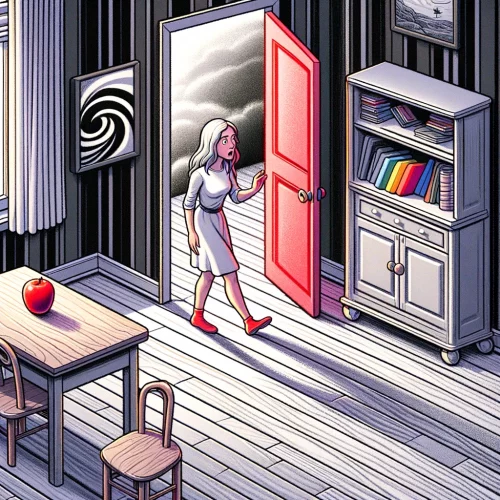Mary’s Room
Understanding Mary’s Room
Mary’s Room is a brain-teaser that philosophers use to learn about how we understand the world. It’s about a scientist named Mary who knows every scientific fact about colors but has never seen them. When she sees a color, like red, outside of her black-and-white world, the question is: does she learn something new? This puzzles us because if she knew everything from books and studies, shouldn’t she already know what red looks like?
Imagine a tricky riddle where someone has read every book about what apples taste like but never eaten one. When they finally have a bite, they discover a whole new sensation that books couldn’t teach them. This is like Mary’s Room. It helps us explore why experiencing something might be different from just knowing about it in theory, and this can make us question whether everything can really be explained just by science alone.
The Paradox of Mary’s Room
Mary’s Room poses a challenge to the idea that knowing facts is the same as experiencing the world. It tells us that maybe there are parts of life, like seeing colors or tasting food, that you can’t fully understand just by reading or learning – you need to experience them directly.
Examples of Mary’s Room
- Like a musician who understands the theory of music but hears a new instrument for the first time: They’ve learned about the sounds in books, but actually hearing it is a totally new experience.
- A chef who knows every recipe for chocolate but has never tasted it: Reading the recipes, they understand how it should be made, but tasting chocolate gives them a new kind of knowledge that recipes didn’t.
- A poet who writes about the sea without ever having seen it: They might use all the right words, but until they stand in front of the ocean, they won’t fully grasp its vastness and beauty.
- An astronaut trained for space but finally leaving Earth: They have learned about space travel, but the real feeling of leaving our planet is an entirely new experience.
- Someone who knows all about snow from books but touches it for the first time: They can’t understand the sensation of cold, wet snowflakes melting on their skin until they feel it.
Why it Matters
Mary’s Room isn’t just a tricky question without an answer. It’s important because it makes us think about how we really know what we know. This isn’t just for philosophers; it affects everyone. It can change how we understand learning, like realizing that doing something might be the best way to learn it. Also, it affects technology. As we build smarter computers, we wonder if they can ever really ‘understand’ things like we do or if they’re just programmed with facts.
Related Topics
- Qualia: Qualia are the feelings or experiences we have, like the redness of an apple. Mary’s Room makes us ask if qualia can be explained by science or if they are special and beyond science.
- Consciousness: This is about what it means to be awake and aware of yourself and the world. Mary’s Room helps us question what part of our mind is behind our experiences.
- Dualism: This is the idea that the mind and body are two different things. Mary’s Room might make some people think there’s a part of us that isn’t just physical, like seeing colors for the first time.
Conclusion: The Significance of Mary’s Room
Mary’s Room is more than just a puzzle; it’s a window into the mystery of human experience. By considering Mary’s story, we see that there might be more to knowing than just learning facts and that our experiences are a crucial part of understanding the world. This experiment invites us to keep an open mind about the nature of our minds and encourages us not to take our own experiences for granted. As we move forward, whether in science, learning, or simply living life, Mary’s Room reminds us to appreciate the full spectrum of knowledge, both what we can learn and what we must experience.
